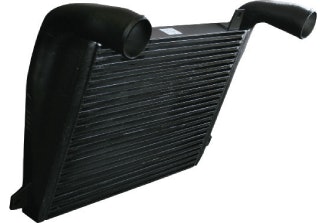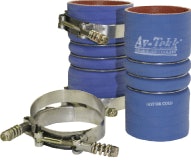A Look At Charge-Air Coolers
By Denise L. Rondini, Executive Editor
In this installment of the Reman Update, Jay Miller, vice president of Av-Tekk, a division of Diesel USA Group, talks about remanufactured charge-air coolers.
TPS: What is involved in the remanufacturing of charge-air coolers?
Miller: To understand the remanufacturing of a charge-air cooler (CAC) one needs a definition. The trade association that tends to oversee the service of CAC product is NARSA, The International Heat Transfer Association. Charge-air coolers are either new or remanufactured.
However, truck owners need to understand that by NARSA’s definition a cooler can be termed as new when the “tanks,” “horns,” or most correctly, “manifolds” are separated from the heat exchanger section, “core” or “brick,” and a new heat exchanger section is re-welded to those manifolds. However, those owning heavy-duty vehicles may choose to term that remanufactured. So nomenclature can be confusing.

While technically the CAC has no moving parts — versus the turbocharger that feeds it boosted hot air — it commonly cannot last as long in-service as that turbocharger feeding it.
While the turbocharger can rotate beyond 100,000 RPM, the cooler can crack and leak the turbo’s boosted air causing excessive smoke, and low-power complaints; and that happens very gradually as the thermal crack grows over time.
TPS: Are there any new developments in charge-air coolers remanufacturing?
Miller: There really are not any new developments in CAC remanufacturing, but there are elements of construction that heavy-duty parts marketers and truck fleets need to be aware of.
The most popular design used for original equipment/first-fit vehicle production is known as the tube and fin design. This design works well, and is the lowest cost method for new production. However, it will typically not last as long in service as other methods of cooler construction.
The tube and fin design employs the use of an assembly component called a header plate. The header plate is the component part in the tube and fin design where most thermal fatigue-type failures occur. In fact, a Society of Automotive Engineers study revealed that approximately 95 percent of all CAC failures were within the header plate.
Remanufactured coolers made from replaced and re-welded heat exchanger center sections commonly use tube and fin type replacements. Still, there are other designs that employ the use of flexible grommets, or gaskets to seal the seam between the heat exchanger section and the air manifolds.
Some of those designs still are sold, some are not. The bar and plate type of construction completely does away with the use of the header plate entirely, and so with it the majority of causes for failure.
While a re-welded center section may be an acceptable method for remanufacturing, the choice of whose heat exchanger center section is used also can correlate directly to the cooler’s efficiency and its durability.
Once assembled, it’s extremely difficult for the truck parts professional or fleet to determine the origin as to whether it is an OEM quality component not.
The bar and plate form of construction is a well-known and established form of cooler construction. It is rarely used in new vehicle production because of its high cost to manufacture.
In the service replacement aftermarket it is very common for superior forms of construction to be more cost-effectively available simply because they travel through fewer layers of redistribution handling and can arrive at the customer as a better product for equal to or less than the [original] design used at the OEM level.
There are many products in the automotive and heavy-duty aftermarket that follow this model such as exhaust systems, starters, alternators, pistons, and of course charge-air coolers among others.
TPS: What are the benefits of remanufactured charge-air coolers?
Miller: The remanufactured charge-air cooler has potentially the benefit of a lower cost to the end-user. However, as previously mentioned selling or purchasing a remanufactured cooler can be risky. An extremely low price may signal a sub-standard quality part that does not live as long, or has lowered efficiency causing poorer fuel mileage and increased emissions.

Replaced center sections may be what you’re getting even if it’s called a “new cooler” by industry definition. So asking the question, “is it 100 percent new, or does it reuse salvaged manifolds?” is valid and tells you a bit more about what to expect.
TPS: How do remanufactured charge-air coolers fit into a distributor’s parts strategy?
Miller: The charge-air cooler is not attractive to some distributors simply because they are space intensive and relatively expensive. Also, there are dozens upon dozens of different configurations driving inventory needs up.
The characteristics of the CAC are very contrary to [the way] many businesses wish to [operate]. Consequently the CAC, in general, is commonly under-distributed by independents.
However, if a distributor is customer-focused, and if that distributor sells items such as turbochargers, [fuel injectors], air and fuel filtration, and other products that operate in the area of handling or delivering the mass-flow of air and/or fuel to an engine, the charge-air cooler is a logical product to complement their service offering to their marketplace.
The charge-air cooler is the [only] non-electronic engine component that is chassis-specific. What this means is each cooler is designed by and/or for each vehicle builder, that’s why there are so many specific designs.
When it becomes married to the engine it becomes an engine part where failure of that part causes engine behavioral problems that easily could be confused with a failed turbo, injector, fuel filter or transfer pump, etc. The last thing any distributor wants to do is to tell his customer, who thought he had a turbo or injector problem, his problem is a part the distributor does not handle.
This is why some distributors, who sell turbochargers and have added CACs to their product line, promote themselves as being “charge-air systems” specialists. It is a simple product extension to the same product category.
TPS: Does the aging truck population present opportunities for remanufactured charge-air coolers?
Miller: Yes, of course it does. The typical charge-air cooler lasts for three to five years. A typical Class 8 truck lasting 15 years in the North American market can easily go through three to five coolers in that 15 years of useful life if it always replaces a tube and fin design with another of the same type.
The opportunities for the typical distributor however are inside of selling a superior brand that offers a longer in-service life. That allows differentiation of product versus the typical tube and fin type design.
TPS: What do you see in the future for remanufactured charge-air coolers?
Miller: It will be less and less over time. The brand options for cost-effectively buying and selling high-quality replacement coolers is systematically obsoleting the remanufacturing of the charge-air cooler.








